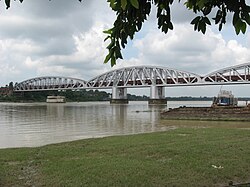


The Jubilee Bridge (Bengali: জুবিলি ব্রিজ) is a former rail bridge over the Hooghly River between Naihati and Bandel in West Bengal, India. It provided an important connection between Garifa railway station and Hooghly Ghat railway station.
The Jubilee Bridge was opened on 16 February 1885 in the Golden Jubilee of Queen Victoria. Construction began in 1882 and was completed in 1887. The Chief Engineer in charge of construction works was Lt Col Arthur John Barry, nephew of Sir John Wolfe-Barry, project engineer of the London Tower Bridge.[1] The Bridge was designed by Sir Bradford Leslie, Chief Engineer in India and Alexander Meadows Rendel. Its steel was manufactured by Hawks Crawshay of Gateshead in England and James Goodwin of Motherwell in Scotland. Bradford Leslie also designed the floating pontoon bridge across the Hooghly in Calcutta, which was replaced by the Howrah Bridge in 1942 and the Gorai River Railway Bridge near Kushtia in Bangladesh. He was the son of the American painter Charles Robert Leslie, ultimately Professor of Painting at the Royal Academy in London.
The Jubilee Bridge is noteworthy in that it is a cantilever truss bridge, constructed entirely by riveting, without any nuts or bolts used in the construction.
- ^ Frederick Arthur Crisp Visitation of England and Wales, Volume 14, London (1906)